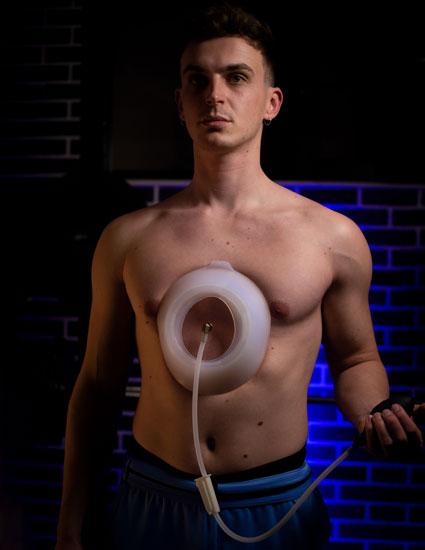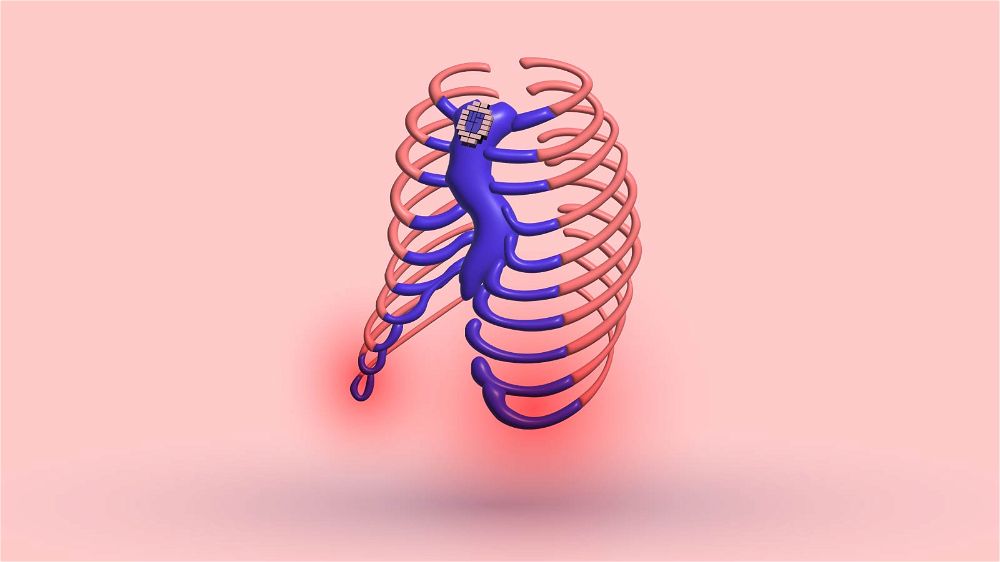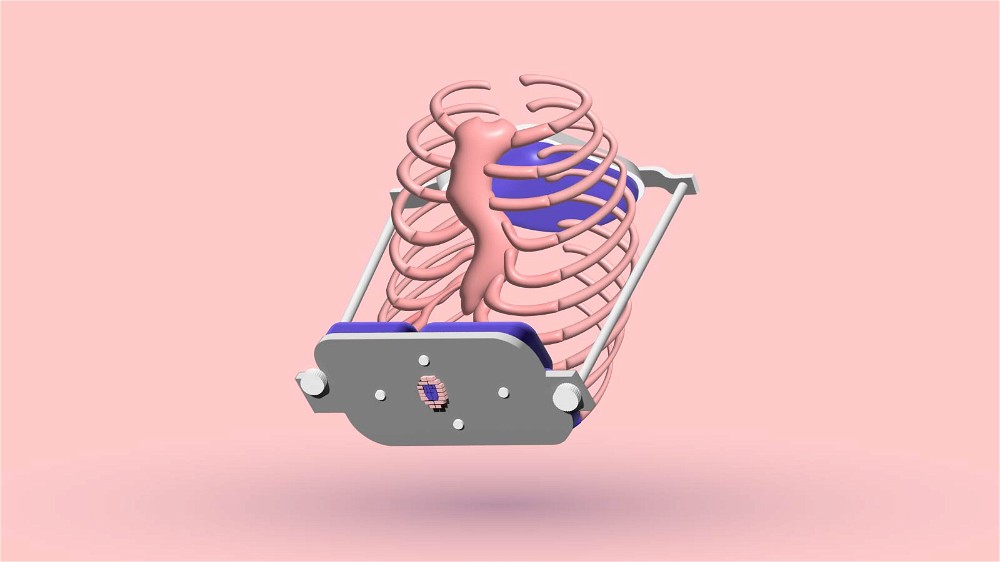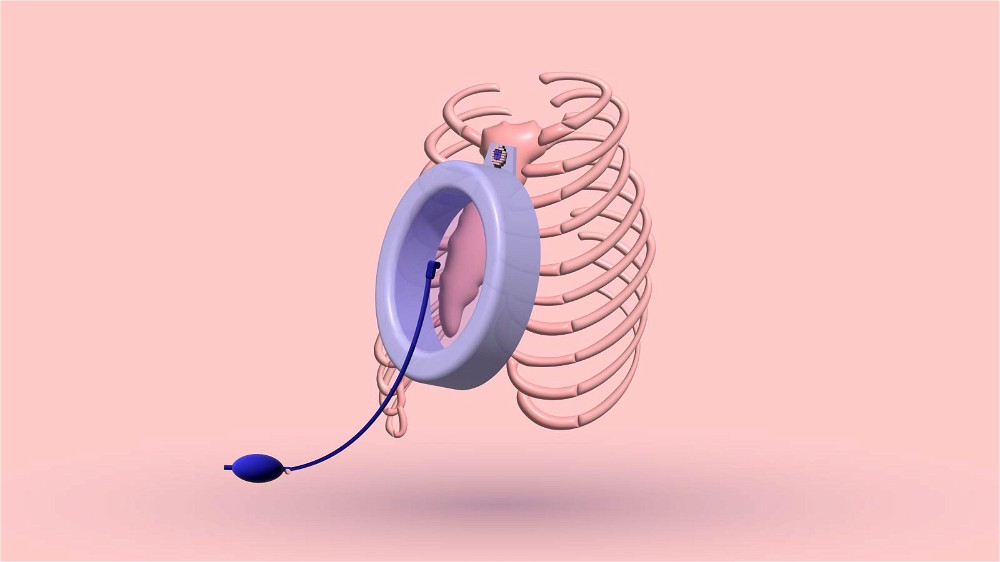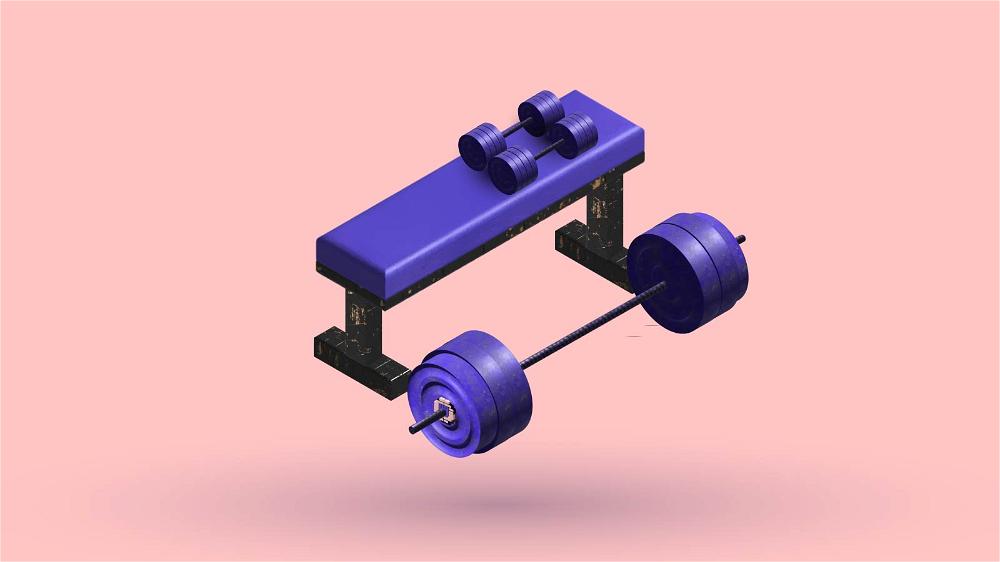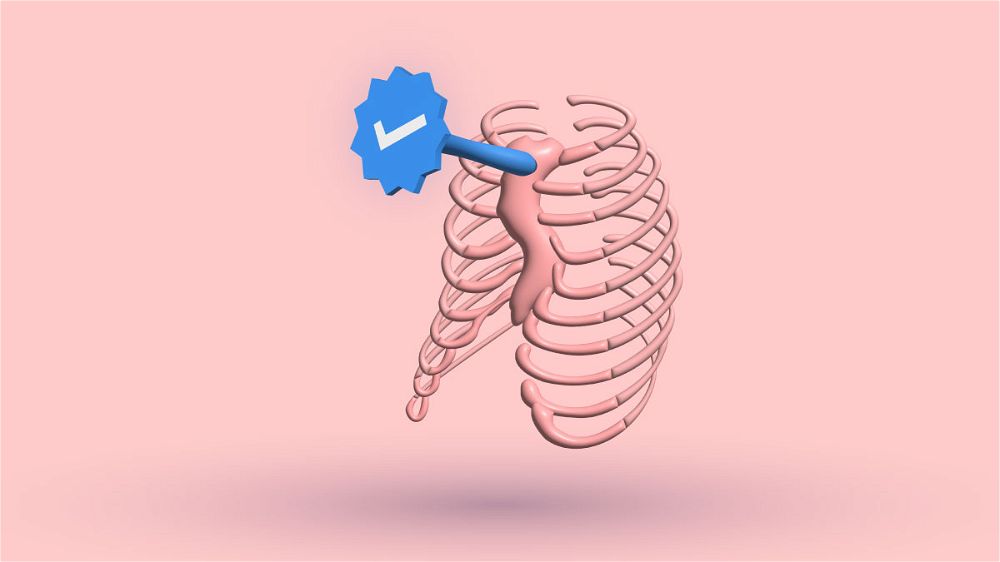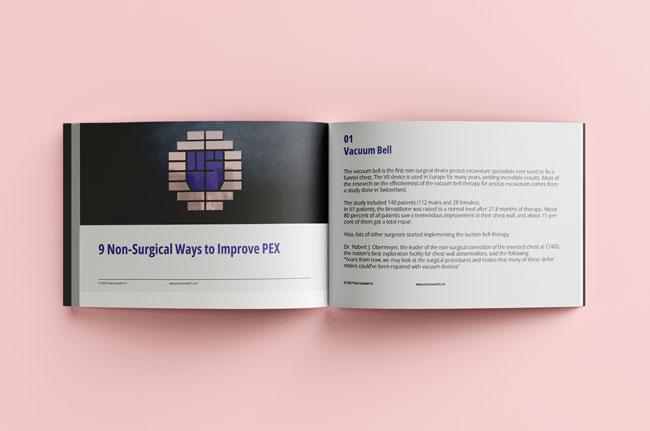Pectus posture can also be described as “poor posture.” However, there are a few typical patterns that pectus excavatum sufferers have. In my coaching experience, many individuals with sunken chests have the same posture patterns.
Many overlook the terrible posture and pay zero attention to how they carry themselves throughout the day. The exact reason why pectus sufferers acquire such posture is unclear.
The purpose of a corrective exercise program to fix pectus posture is to make patients straighten their thoracic spine and pull their shoulders back and down. That will establish a “military” posture.
5 MOST COMMON POSTURAL PROBLEMS

Pectus excavatum sufferers usually have a posture that further worsens the deformity. It is exacerbated by a forward slouching of the shoulders, kyphosis, and belly that sticks forward.
For example, a moderate deformity will appear as severe simply because the posture is terrible. Most people with pectus excavatum today have a kyphotic spine (head rounding forward), especially teenagers.
We are a generation that plays many video games throughout the day. That makes the indentation appear worse. The stretches and exercises aim to open your chest and pull the shoulders back.
Standing upright with a robust posture can instantly make the hole in the chest appear less prominent. In everyday life, walking around with a good posture is critically important. Corrective stretches and exercises help you make this a habit.
1. KYPHOSIS

Kyphosis of the thoracic spine is one of the most common pectus excavatum postural problems. Additionally, rounded shoulders are also extremely common.
You can easily recognize kyphosis by the forward curve in the upper part of the back and a head that sticks forward.
However, it can’t be easily identified if the kyphosis is moderate.
If it is severe, it looks like the person is bending forward. Most patients that have kyphosis don’t have any physical symptoms. But, in more severe cases, it can cause back pain, muscle stiffness, hunched back, and stiff hamstrings.
The way to fix this is based on the severity of the kyphosis. Physical therapy and stretching the tight muscles are essential to improve thoracic mobility and strengthen the postural musculature.
I HAD KYPHOSIS
I used to have a very kyphotic posture. That was something that I grew up with. It resulted from playing video games on my computer and sitting at the desk at school for most of my days.
I rounded my upper back, and my pec minors were extremely tight. To correct the kyphotic posture, you must fix and stretch daily.
I make all of my young clients who have kyphosis (rounded upper backs and forward sticking head) do a prehab exercise before doing a bodybuilding workout.
STRENGTHEN SCAPULAR MUSCLES


First and foremost, they must stretch their pec minor on the wall and the lats using a rubber band attached to the pull-up bar of a squat rack.
Doing that will pull them back into a proper posture automatically. Then, I make them do resistance band pull-apart and band dislocations.
The point of these exercises is to pull back the scapula muscles that are weak and long. I want them to tighten those muscles up and make them healthy.
It would be best to loosen up the chest muscles first and then strengthen the back muscles across the midsection.
2. FORWARD HEAD POSTURE
As I previously said, I had a horrible posture for many years because of playing video games. My posture was awful.
I focused on strengthening my upper back muscles when I started strength training. I worked on thoracic extension, stretching, foam rolling, and every other physical activity supporting a good-looking physique.
The problem was so bad that I had a “lump” on my neck, which looked like a pile of meat when I stood straight. Nowadays, my body and the bump are corrected.
DOWAGER’S HUMP
After extensive research on the subject, I discovered it was called “Dowager’s Hump.” It is a byproduct of your head “falling off” while being hunched forward.
My face was close to the screen when I played video games, and I unnaturally extended my neck. My body had to protect and respond to my head’s unnatural placement.
When you bend forward all the time, the posterior part of the vertebra starts to open up. When you crunch down on the anterior portion of the vertebrae, you can even end up with a bulging disk.
Your body responds by creating a hypertrophy response in the back of the neck.
STRETCH AND STRENGTHEN
So, what you need to do is the following:
It would be best if you used corrective stretching. Often, the damage is so severe that it is tough to bring yourself back to balance. However, I assume you’re young and pliable enough for the exercises I will show you.
Strengthen the Deep Neck Flexors
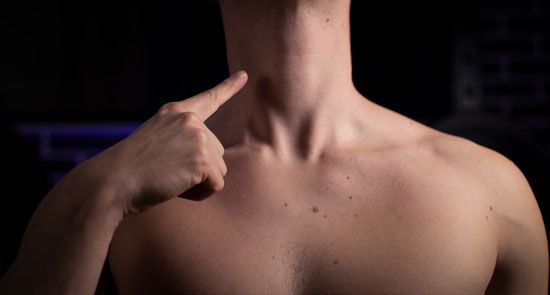
Forward head posture is a byproduct of kyphosis, but it is so common that you must resolve it independently.
The muscles within the neck muscles in the front help support the “tucking in” of the head. These muscles are called deep neck flexors.
The stretching and corrective exercise routine balance out the neck muscles, so the deep cervical muscles are developed in proportion to the cervical extensors (muscles on the back of the neck).
Muscular Imbalance

The extended back muscles are often very tight, and the deep neck flexors in the front are weak. This causes an imbalance that results in an ugly head posture in pectus excavatum patients.
It would help if you created balance by strengthening the front neck muscles and stretching the tight muscles at the back of the neck. You might need neuromuscular therapy to get someone skilled to mobilize the vertebrae.
Press Tongue on the Roof of Your Mouth
The forward head posture can worsen with time. Integrating the exercises I showed you into your daily life would interest you. When doing core exercises, try to press your tongue on the roof of the mouth.
It will contract and strengthen the cervical flexors, which are usually the weak part of the neck.
3. SHOULDER ISSUES
You must have strong and healthy shoulders if you want a good posture.
Fixing shoulder problems will have a tremendous impact on your overall well-being. In pectus deformities, the shoulders can be affected in several ways.
UNEVEN SHOULDERS
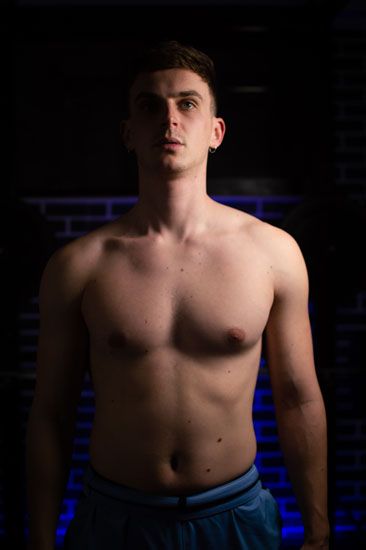
In this case, the shoulders don’t appear on the same horizontal level. They are imbalanced, which can cause problems if left untreated.
Scoliosis is often the cause of uneven shoulders in pectus excavatum patients. It puts excessive and uneven pressure on the sternum and ribs, tilting the sunken breastbone. This usually happens in patients with asymmetric pectus excavatum.
ROUNDED SHOULDERS
This is a synonym for bad posture. This happens when the shoulders are hunched over.
SCAPULA WINGING
This is also known as winging of the shoulder blades. It happens by lateral rotation of the shoulder. It causes the shoulder blades to stick out and look prominent.
As with other chest wall deformities, pectus excavatum patients can have scapulothoracic dysfunction. That’s when the scapula of the shoulders moves in an unnatural pattern.
It can be caused by
- Weakness,
- Imbalance,
- Muscular tightness,
- Detachment of scapulothoracic muscles such as the serratus anterior, latissimus dorsi, rhomboids, and trapezius muscles.
SCOLIOSIS
Scoliosis is an irregular, sideways spine curvature that can often be seen in patients with pectus excavatum. Usually, such spinal problems can be seen in asymmetric pectus deformities.
4. POTBELLY
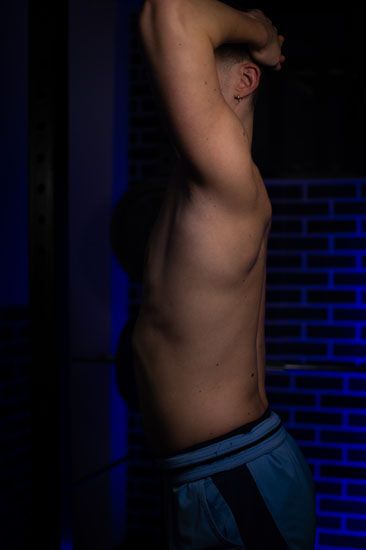
Even though most pectus excavatum sufferers are skinny, their stomachs and belly can look swollen, as if they have a “potbelly.”
Most of the time, this is further exaggerated if the patient has flared ribs. Forward pelvis rotation (anterior pelvic tilt) makes the spine curve, making the abdomen protrude more.
On rare occasions, the potbelly appearance can be caused by a posterior pelvic tilt.
5. LORDOSIS
There is a natural lordotic curve that is entirely normal. However, if the arc bends too far inward, it will affect the lower back and, sometimes, even the neck.
This is called Lordosis. You can feel muscle pains because of this. Lordosis is often related to anterior pelvic tilt and “potbelly.”
This can be fixed with proper physical therapy and strengthening the abdominal and lower back musculature.
Potbelly and Lordosis are less common than the previously mentioned posture issues. However, if you notice some of the symptoms, make sure you correct these problems.
EXERCISE IMPROVES POSTURE
Every type of exercise has the potential to improve pectus posture. Take running, for example. It forces the patient to stand up straight and breathe deeply.
This also helps with improved muscle tone. The same goes for other sports like basketball, football, swimming, etc. In general, exercising is proven to improve the patient’s well-being.
It will also help with confidence, allowing the athlete to stand more upright. However, if you perform some exercises in the gym wrong, it can worsen your posture. I will talk about this in the text that follows.
WHAT TO DO BEFORE STARTING
Before starting any posture-correcting exercise plan, the individual needs to be motivated. If not, they will feel like it is a waste of time.
In my experience, the quickest way to motivate yourself is to look in the mirror and observe how attractive your body looks when standing up straight with a good posture. See how much of a role the posture plays in the sunken chest appearance.
BIGGEST PROBLEM
Most patients don’t focus enough on improving their posture. They think adding muscle mass to the chest muscles will “fill” the dent so that it will be less noticeable.
Unfortunately, things aren’t as easy as this. Working out the chest muscles can sometimes worsen your posture, making the sunken chest appearance more evident.
I WORSENED MY POSTURE BY TRAINING MY CHEST
I was a victim of this mentality. All I focused on were my chest workouts. I wanted to build those flashy mirror muscles without paying attention to the back muscles needed for optimal posture.
I thought stretching was for women and that it was a waste of time. Surprisingly, my inverted chest deformity worsened as I went to the gym.
Then I realized that improper workouts made my posture worse. I was skipping days when I was supposed to work my muscles in the back and legs.
I replaced them with chest workouts. It was like that until I felt a sharp pain in my shoulders. I found the source of the pain and realized I was working out improperly.
4 EXERCISES TO FIX PECTUS Excavatum POSTURE
I stumbled upon an article that described what a pectus posture was. It was an article written by the McMaster Children’s Hospital and included corrective pectus excavatum exercises for posture.
I started implementing those exercises and saw a noticeable improvement in my appearance, mainly because my posture improved.
Let me share these exercises with you with a slight modification that I figured would be even more beneficial.
SACROSPINALIS EXERCISE
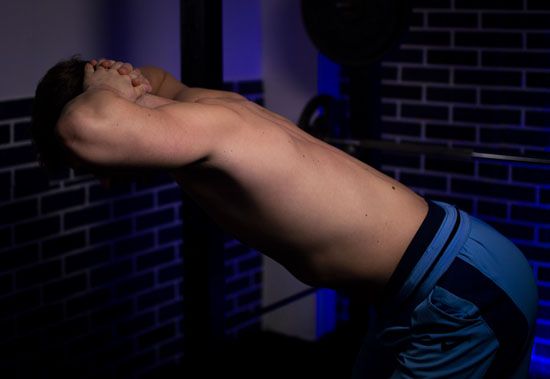
To start this exercise, you need to put the hands behind your head, with the fingers interlocked. Pull the elbows back as much as possible while keeping your head and neck straight.
In this position, you can feel how your chest is filling up anteriorly. When you achieve this position, bend from the hips forward and down until you reach a horizontal position.
Hold this position for two seconds, then straighten up again. Try to endure any discomfort you feel. Make sure you don’t flex the neck in this position. You will activate muscles that you don’t need.
Ensure that your spine is straight when you reach the horizontal position without flexing the neck muscles. Repeat this exercise 30 times in a session.
PEC STRENGTHENING EXERCISES
There are two beginner-friendly pec strengthening exercises that you can safely do to improve your “Pectus posture.”
PUSH-UP
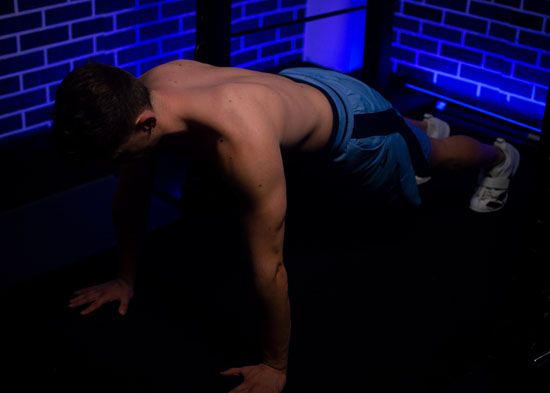
The first one is a simple push-up. This is probably the most popular exercise worldwide. However, not everybody knows how to perform it properly.
On the other hand, if you execute this exercise correctly, it will activate many muscles required for a healthy posture, including your core.
Aim to perform 30 push-ups in each session. If you can’t do them at once, try to divide them into two or more sets. Make sure you’re performing the exercise correctly so that it will activate your pec muscles.
DUMBBELL FLY
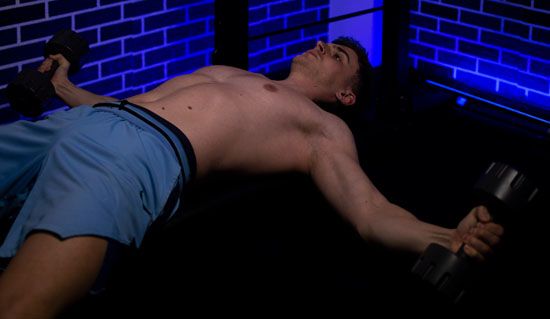
Do this dumbbell fly modification if you suffer from poor posture and have shoulder pain. The classic dumbbell fly is done on a bench with heavier dumbbells, which puts excessive stress on the shoulders. In our case, we are more prone to injury due to poor posture.
You must lie on the ground and on your back to do the second exercise. Bend at the knees for more stability. Grab some small dumbbells in both hands. Then, straighten your arms and position them at a 90-degree angle to your body. While keeping your arms straight, bring them together at the midline above your chest.
As I said, this exercise is much easier on your shoulder joints because it starts on the ground. This is a beginner-friendly dumbbell fly, suitable for strengthening the chest without any negative consequences on your joints.
CHEST EXPANSION
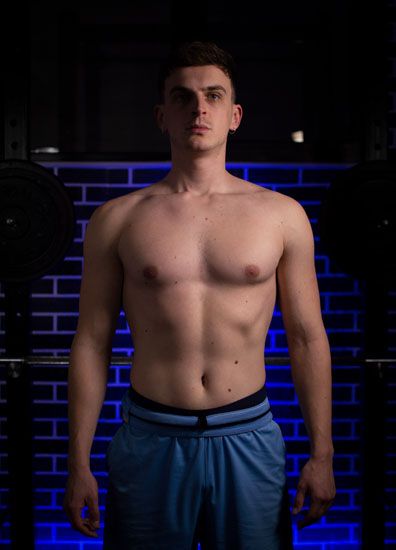
You start this exercise by inhaling as much air as possible while pulling the shoulders back and down. Then, hold your breath for as long as you can, with the chest pushed outwardly.
Do this while standing up straight with a robust posture, with your shoulders back. When inhaling, you should expand your chest as much as possible until you reach the “military” position.
The point of this exercise is to see how long you can hold the air while keeping the posture stable. This exercise will increase your VO2 max capacity and expand your lungs. Repeat it 30 times in a session. This short workout program doesn’t take any time at all. All you need is 10 minutes of your day.
The article’s authors recommended that the patients execute the exercises immediately after waking up and the last thing before going to bed in the evening.
Remember that this program won’t pull the sternum out of the dent. However, it will improve your pectus posture, making your abnormality less evident.
BIGGEST MISTAKES YOU SHOULDN’T DO
- You shouldn’t train your chest only while neglecting your back muscles.
- Don’t walk or sit with your shoulders rounded and your head sticking forward. Even though you may feel the urge to do this, try to fight it off. The best way to walk straight with a robust posture is to walk upright. Fake it till you make it.
WHAT TO DO
It would help if you stretched the tight musculature in the following muscles daily.
- Neck,
- Shoulders,
- Chest,
- Hips.
Focus on building your back muscles by working out the musculature responsible for the “pulling” pattern more than the muscles for the “pushing” pattern.
Practice proper posture in your everyday life. Perform yoga in addition to the posture-improving exercises I mentioned above.
Pectus Carinatum Poor POsture
It's still unclear why patients with pectus carinatum develop lousy body posture. It's probably a combination of factors, including the deformity's adverse effect on thoracic mobility, the weakness of the shoulder and upper back muscles, and poor core strength, all of which can affect the proper upright position.
Scheuermann Syndrome
The excessive outward curve of the spine, such as Scheuermann’s syndrome, is frequent in pectus carinatum patients.
This syndrome causes a visible curvature of the upper thoracic spine and causes a rounded shoulder appearance.
The Bottom Line
Correcting poor pectus posture will make your deformity less noticeable. You can perform strength training exercises without pain when you fix your posture. This can speed up the process of improving your physical appearance. The most crucial part is that you will have a lot more confidence.
You will no longer be slumped over. Try to identify what postural problems you have from the list I showed above, and try to follow an exercise and stretching program to correct these issues. Thank you for reading!
4 Sources
- PECTUS EXCAVATUM EXERCISE INSTRUCTIONS. :1. Available from:
https://www.hamiltonhealthsciences.ca/wp-content/uploads/2019/03/pectusexcavatum-exercise-instructions.pdf - Pectus Clinic [Internet]. [cited 2022 Dec 1]. Available from: http://www.pectusclinic.com/
- How You Can Fix a Dowager’s Hump + Prevention Tips – Cleveland Clinic [Internet]. [cited 2022 Dec 1]. Available from: https://health.clevelandclinic.org/howyou-can-fix-a-dowagers-hump-prevention-tips/
- Muscle Performance in Neck Pain - Physiopedia [Internet]. [cited 2022 Dec 1].
Available from: https://www.physio-pedia.com/Muscle_Performance_in_Neck_Pain





